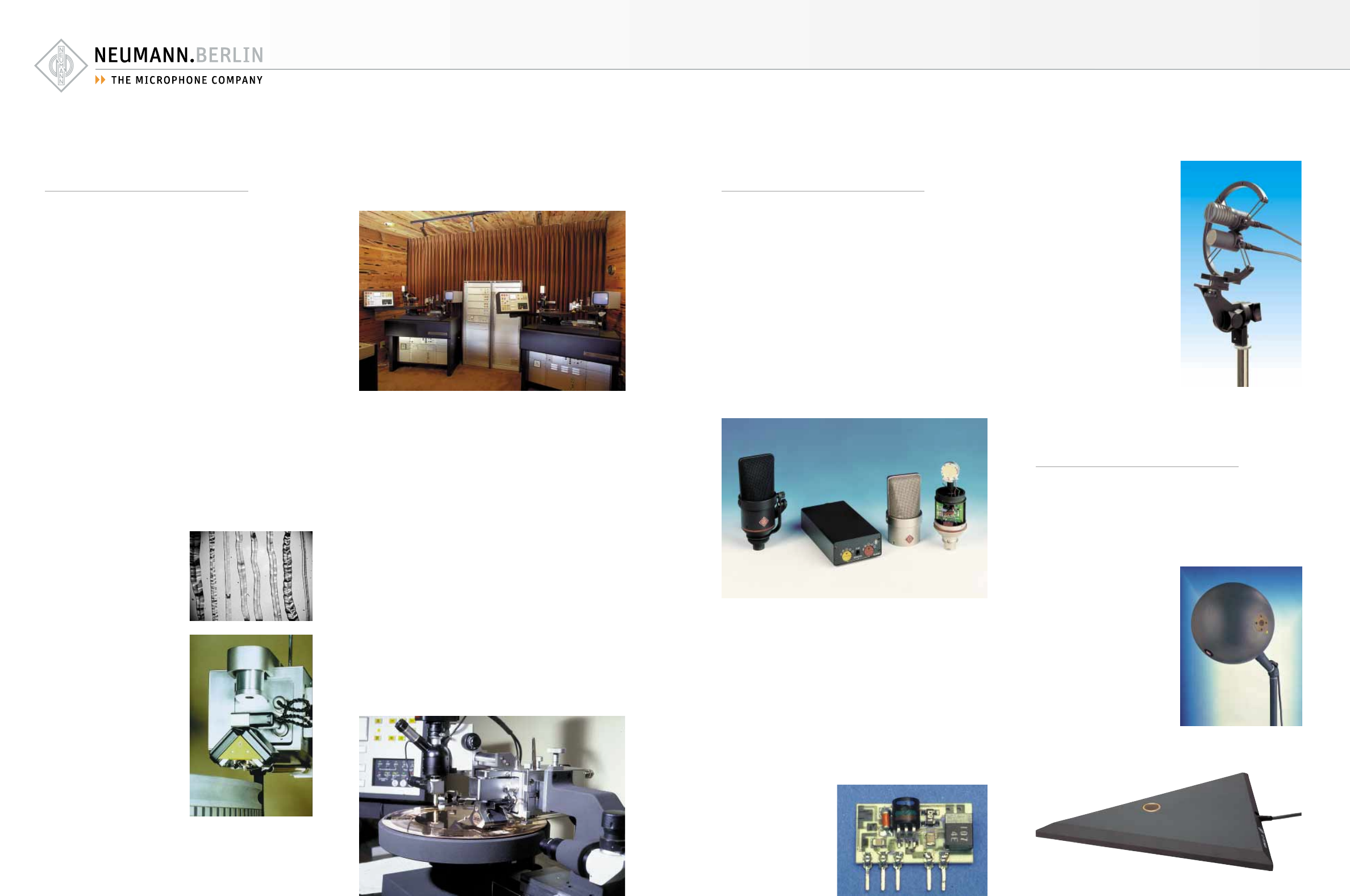
Neumann History
1110
Refinements in
Phonographic Technology
Up until around 1953, Neumann built disk-cut-
ting lathes for phonograph records with a con-
stant groove pitch. Between 1953 and 1955,
Neumann developed a method of varying the
groove pitch depending on the recorded am-
plitude. To this end, an additional playback
head was mounted on the tape deck. This ad-
ditional playback head determined the groove
amplitude to be recorded approximately one
half-rotation of the turntable in advance and
fed this value to the cutting lathe as a control
signal via a corresponding drive amplifier. Of
course, this also required a separately varia-
ble pitch drive. For the first time, this made
it possible to extend the playing time of an
LP phonograph record to approx. thirty min-
utes.
So far the records had been monophonic disks
made using lateral recording. In 1956, Neu-
mann debuted its first stereo disk-cutting
lathe, the ZS 90/45, which supported both lat-
eral and vertical recording. The lathe was set
up to cut the two stereo channels into the two
flanks of the groove at a 45° angle. Over the
years, other disk cutting lathes
were developed, the quality of
which improved continually.
These were all electrodynami-
cal feedback cutterheads. This
model series continued with
the SX 45, SX 68, SX 74 and
finally the SX 84.
Many companies made a name
for themselves with their prod-
ucts on the disk cutting mar-
ket. These included, for exam-
ple, Ortofon, Westrex, Scully,
Fairchild, Dauphine, and others.
By the end of the fifties, Neu-
mann was the only company
left that could deliver com-
plete tape-to-disk transfer
equipment. Neumann saw this
position as a serious obliga-
tion to continue refining pho-
nographic technology. This
was reflected in the refine-
ment of the disk cutting lathes
and improvement of the cut-
ting procedure.
One interesting phenomenon in this connec-
tion is the tracing distortion that results from
the difference in geometric shape between the
tool used to cut the grooves and the playback
stylus. The cutting stylus is shaped like a
spade, while the playback stylus is spherical.
During playback, this results in tracing distor-
tion, which mainly contains the 2nd harmon-
ic. In 1968, Neumann built the Tracing Simu-
lator that solved this problem.
In the early seventies, Neumann successfully
developed, in conjunction with TELDEC, a me-
chanically recorded video record that was played
back via a pressure pickup. The experience
gained in this connection led to another signif-
icant improvement in the process of cutting pho-
nograph records. In the beginning, phonograph
records were cut in bee’s wax and for years
thereafter in a phonographic foil coated with
nitro-cellulose lacquer. Neumann introduced the
DMM technology, in which the phonographic foil
was replaced by copper foil, resulting in
DD
DD
Direct
MM
MM
Metal
MM
MM
Mastering,
DMMDMM
DMMDMM
DMM. This resulted in substan-
tially improved pulse fidelity of the recorded
signal, which represented another significant
improvement in the sound quality of phono-
graphic records.
One Step Ahead Again:
The TLM Technology
At the 1983 AES-Convention in Amsterdam,
Neumann unveiled a brand new series of mi-
crophones with refined circuitry: the
TT
TT
Transfor-
mer
LL
LL
Less
MM
MM
Microphones of the “fet 100” series.
The first representative of this series was the
switchable TLM 170 with five directional pat-
terns from which to choose. It used the same
dual-diaphragm capsule as its somewhat older,
transformer-equipped brother, the U 89.
Each microphone represented a considerable
improvement in the common dynamic range of
studio microphones at its respective time of in-
troduction. Their electronics evidenced lower
residual noise and, simultaneously, higher mod-
ulation levels than predecessor models. Further-
more, they were also a novelty in the market
because they were the first to provide wide-an-
gle cardioid and hypercardioid directional pat-
terns in addition to the omnidirectional, cardi-
oid, and figure-eight patterns common at the
time.
The “especially open, free sound” of the TLM
technology, which made it possible to transmit
fine structures “as if a curtain had been pulled
aside”, encouraged Neumann to quickly equip
other microphones with this system.
In order to be able to fit
the complex circuitry
into miniature micro-
phones, however, it first
took an additional de-
velopment step: hybrid
technology. This tech-
nology even made it
possible to incorporate
all electronics right in the cap-
sule housing, thus giving rise
to the “active capsules” of the
KM 100 series.
So Neumann’s miniature micro-
phones not only took another
clear step toward improved
technical data, but now the
capsules could be used with the
help of accessories such as
goosenecks, stand mounts, var-
ious cables, and tilting devic-
es without electro-acoustic
loss.
This miniature microphone
family now comprises seven
different capsules with all cus-
tomary directional patterns.
These also include stereo mounts for XY, ORTF
and MS recording techniques.
The Specialists
Besides the aforementioned dummy head, in
1992 the KFM 100 Spherical Surface Micro-
phone was introduced for an additional stereo
recording method.
This microphone had two small, high-quality
condenser capsules arrayed on
the diameter of a head-sized
wooden sphere. In the
GFM 132 Boundary Layer Mi-
crophone, these capsules had
been optimised for sound re-
ceived at oblique angles. Thus
the KFM 100 was a micro-
phone for especially natural
stereo recordings with tremen-
dous acoustic depth, making it
ideal for miking highly com-
plex acoustic fields, such as
those found in churches and
large halls.















